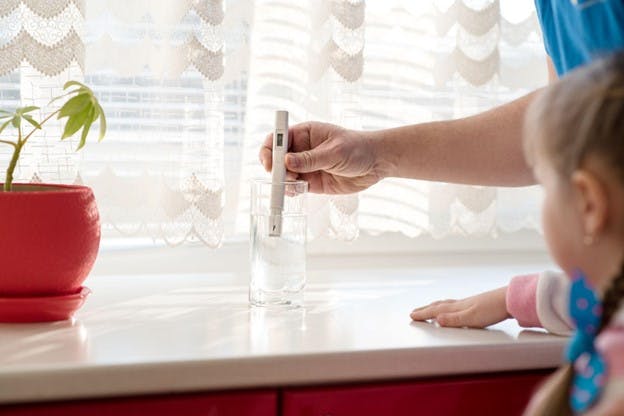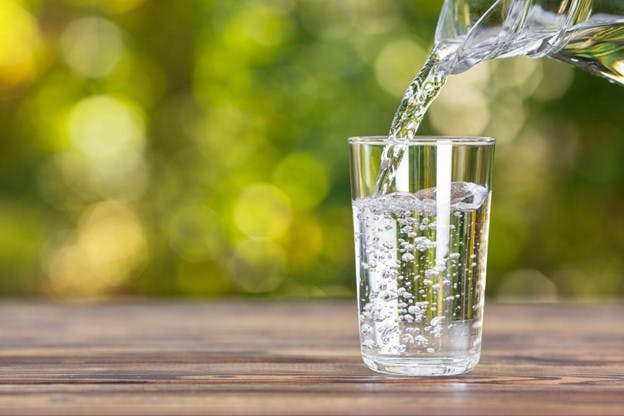🌟 New Arrival! Upgrade Your Water with Our Advanced Pitcher Filter. Shop Now
April 2023
High TDS in Water: When Should You Be Concerned?
Don’t panic, but you should know your water is not pure. Almost no water is, really. Water is an amazing solvent that breaks down and collects all sorts of pieces and particles on its journey through the world. Whether it's traveling through an underground aquifer, a mighty river, or your modern plumbing, it's likely picking up some kind of contaminants that will eventually make it to your tap.
What these contaminants are and how much of each is in your tap water has important implications for your health, pipes, and appliances. If you want an overall measure of these contaminants, one of the things you can look at is the total dissolved solids or TDS in water.
TDS can have a significant effect on your drinking water quality but it's not everything. We’re going to take a deeper dive into what TDS is, what it tells you about your water, how to handle it, and where it could fall short as a measurement of water quality.
What Is TDS in Water?
TDS stands for total dissolved solids. Almost anything in your water that is not pure H2O could be put under the umbrella of TDS, as long as it's small enough. Larger particles are known as total suspended solids or total settleable solids (TSS).
TSS is the stuff you can see floating around in your glass. Anything smaller than two microns in size (one-fiftieth the diameter of a human hair) is considered TDS.
TDS in water usually consists mainly of dissolved substances like inorganic salts and organic matter picked up from the environment.
This can include:
- Heavy metals like lead, manganese, and iron
- Hard water minerals like calcium and magnesium
- Salts like potassium, bicarbonates, chloride, sulfates, fluoride, and nitrates
- Organic matter like algae, silt, and petroleum-based fertilizers
Where Does TDS in Water Come From?
TDS in your drinking water can come from just about anywhere. Some of these impurities are from natural sources like minerals leached from the rocks and soil groundwater passes over. Microscopic bits of decaying organic matter found in lakes and streams can also hang around in your water.
Depending on the water source, there will likely be an array of synthetic pollutants too. Sewage and industrial wastewater can add minerals. If you live in a snowy environment, the salt from de-icing the roads can add more. Chemicals used in mining, construction disturbing minerals in the soil, petroleum-based chemicals from urban runoff, and pesticides from agricultural runoff can all add more TDS to water. Even water treatment facilities often add more with the introduction of chlorine and fluoride.
Is High TDS in Water a Health Hazard?
The U.S. Environmental Protection Agency (EPA) — which sets the standards for U.S. tap water — put TDS on the national secondary drinking water contaminants list. This means that while they create guidelines on the concentration of TDS that should come out of an American faucet, they don’t enforce any limits.
Because the makeup of TDS is not defined by specific contaminants, it’s hard to really say that high levels of TDS are a health risk for human consumption. However, high TDS levels are a water quality issue. They can affect the color, taste, and odor of water. Plus, the particles can stain surfaces and build up in pipes and appliances.
TDS are considered aesthetic and cosmetic problems more than a health risk. But, just because TDS isn’t always made up of harmful contaminants doesn’t mean it’s safe. High TDS could indicate high arsenic or lead levels amongst other things. Also, at very high levels, minerals not usually considered harmful can cause gastrointestinal distress.
According to the World Health Organization, TDS in water above 1,500 mg/L is barely potable and anything over 1,000 mg/L is enough to damage its taste.
How Does Low TDS Affect Water?
If you’ve ever bought a fancy bottle of water and read “mineral water” on the label, you probably know that some mineral content can have positive effects on the water’s taste.
Since TDS includes minerals, water with very low TDS is also low in minerals and is thought to taste flat and lack flavor. In fact, water companies who distill their water (which removes minerals) will usually add a mixture of minerals back in before bottling to restore the taste.
So while super low TDS water isn’t bad for you, you may not enjoy drinking it.
How Can I Measure the TDS in My Water?
The EPA recommends tap water in the U.S. stays under 500 mg/L. If you want to find out if your tap water fits this recommendation, there are several ways.
Water Quality Reports
If your water comes from a municipal source (you get a water bill each month), by law your water company has to put out an annual water quality report. This report has tons of information about what’s in your water and any violations your water company has had over the last year.
While it's not required by federal law for them to include TDS in the report, many will include it anyway. Since these reports are free to access and available on their websites, it's always worth checking before you do anything else. If it's not on the report, you can try calling them to see if they know.
If you get your water from a private well, try one of the two options below.
TDS Meter
A TDS meter checks the electrical conductivity of your water to give you an estimate of your total dissolved solids. It works because salts and minerals are ionized, so they change the conductivity of water.
One thing to note here is that not all contaminants are ionized and some concentrations may be too weak to get a proper reading on. That may make it hard, if not impossible, to get an accurate reading of all potential contaminants like pharmaceuticals, PFAS, microplastics, lead, and others.
At-Home Water Testing Kits and Working With Local Labs
There are many home water testing kits and labs that you can work with to test TDS in your water. The best way to find reputable testing is to consult the EPA’s helpful guide for water testing.
What Does TDS Actually Measure?
TDS measurements just tell you the amount of dissolved solids within a volume of water. They don’t tell you what those contaminants are or how safe or dangerous they are.
Many tests just read the anions (negatively charged ions) and the cations (positively charged ions) to give you some estimation of the total weight of ionized particles in your water supply.
While this can give you a clue about potential water issues, as a standalone number it's more of a starting point for figuring out water quality issues than an exact diagnosis.
What Treatments Are Best for High TDS Water?
Due to the small particle size and the wide range of contaminants that make up TDS, there are just a few treatment processes that handle the job well.
Distillation
Distillation systems turn water into steam, which then separates from the contaminants when in vapor form. That steam is then recaptured in another contaminant-free container, giving you pure water. Distillation systems are usually not practical for home use and can be very expensive. Plus, your water may taste flat if you don’t add some minerals back in.
Reverse Osmosis
Besides expensive distillation systems, reverse osmosis water filtration systems are the most effective at removing TDS from water. Reverse osmosis systems force water through a semipermeable membrane with holes so small that only water gets through.
Because the RO system membranes can be damaged and clogged by larger particles and chlorine, it's a good idea to use a prefilter. HomeWater’s Under Counter Reverse Osmosis 4-Stage water filters have multiple pre-filters built in to keep your RO system healthy for years without replacement.
Water Softeners
High TDS in water typically means you’re going to have hard water. Hard water is water that contains an abundance of mineral solids, like calcium and magnesium.
While hard water minerals are not damaging to human health, they can wreak havoc on your pipes and water-using appliances. Hard water leaves soap scum and a crusty buildup on your surfaces while making your soaps and detergents less effective because they can't lather well.
Using water softeners or salt-free water conditioners can remove or alter the hard water minerals in your water, bringing your TDS levels way down.
Take Control of Your Water Quality With HomeWater
Flowing water is an excellent solvent and it can pick up many contaminants along the way. Measuring the total dissolved solids in your water helps you to know just how much is carried to your tap. While these measurements won’t necessarily tell you what the impurities in your water are, it's a great place to start learning more about your water.
High TDS in water can alert you to the possibility of health-damaging compounds in your water. It can also negatively affect your water's taste, color, and smell. Low levels of TDS, on the other hand, can make your water flat and flavorless.
You can protect your water from TDS and more with HomeWater’s Whole Home and Under Counter Water Filters. HomeWater’s Under Counter Reverse Osmosis 4-Stage Filtration System reduces sediment, chlorine, TDS, barium, cadmium, hexavalent and trivalent, chromium, lead, copper, radium 226/228, selenium, fluoride, and nitrates.
You’ll be left with just the best-tasting, highest-quality water that will have you coming back for more.


